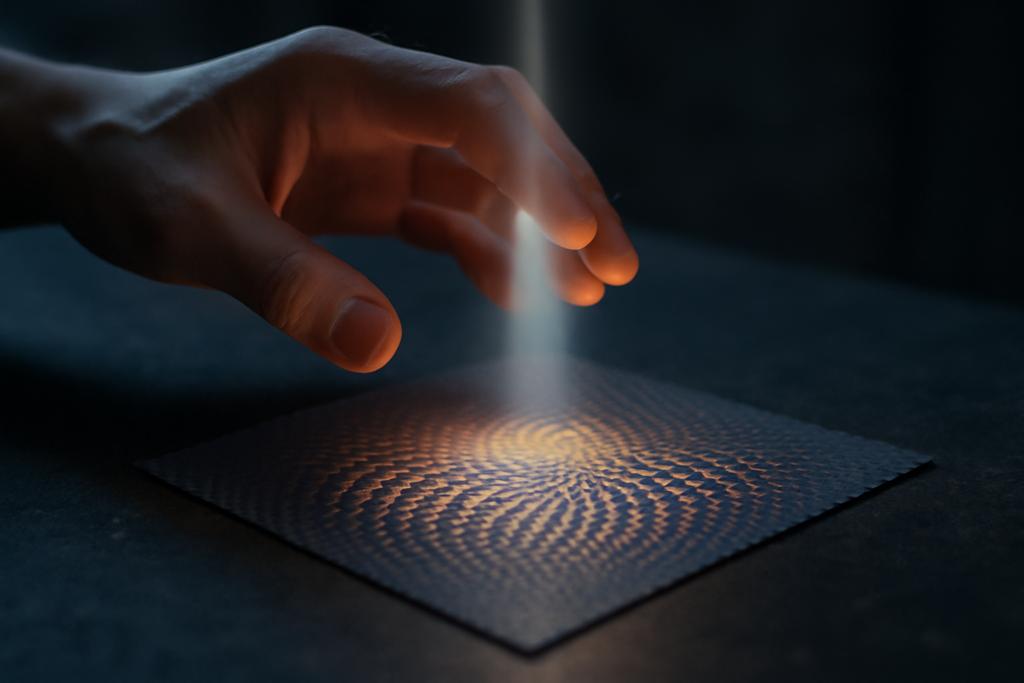When Light Becomes the Architect of Quantum Landscapes
In the world of two-dimensional materials, a subtle twist can unlock extraordinary physics. By rotating atomically thin layers of semiconductors just a few degrees, researchers have discovered a playground of exotic phenomena—from unconventional superconductivity to correlated insulators. This magic lies in the moiré pattern, a delicate interference of atomic lattices that corrals electrons and excitons into periodic traps, reshaping their behavior.
But what if you could conjure these moiré-like effects without physically twisting anything? What if light itself could sculpt the quantum landscape, weaving patterns that confine and control excitons—those bound pairs of electrons and holes that govern optical properties? A team at the Max Planck Institute for the Structure and Dynamics of Matter in Hamburg, led by Francesco Troisi, Hannes Hübener, Angel Rubio, and Simone Latini, has proposed exactly that: a way to mimic moiré physics purely through the design of optical cavities.
Beyond Twisting: Optical Cavities as Quantum Pattern Makers
Traditional moiré engineering relies on stacking two-dimensional materials like transition metal dichalcogenides (TMDs) with a slight twist. This creates a superlattice potential that corrals excitons into a periodic pattern, modifying their energy landscape and optical responses. However, fabricating and controlling these twisted structures is challenging and limited by mechanical constraints.
The researchers suggest an alternative: embedding untwisted TMD bilayers inside spatially structured optical cavities—essentially tiny boxes that trap light waves with a carefully designed periodic pattern. These cavities confine photons in a way that their electromagnetic fields carry momentum, allowing them to interact with excitons differently than in conventional, uniform cavities.
By tailoring the cavity’s spatial structure, the team shows that the light-matter interaction can generate an all-optical moiré potential. This means the excitons feel a periodic landscape not because the material layers are twisted, but because the photons inside the cavity impose a repeating pattern of electromagnetic influence. It’s as if the light itself is painting a moiré pattern onto the excitons.
Classical Light Creates Quantum Corrals
When the cavity is driven by a classical laser field, the periodic photonic modes act like a synthetic lattice potential for excitons. The team used advanced quantum electrodynamical modeling to show that this optical confinement leads to band folding and splitting in the excitonic energy spectrum—hallmarks of moiré physics. The excitons behave as if trapped in a superlattice, but the pattern emerges purely from the cavity’s structured light field.
This approach offers remarkable flexibility. Instead of relying on mechanical twisting, researchers can tune the cavity’s grating periodicity, photon energy, and intensity to program the excitonic landscape on demand. It’s a new kind of optical twistronics, where light replaces the physical twist.
Quantum Fluctuations Stir Exciton Interactions in the Dark
The story gets even more intriguing when the cavity is left in the dark—no external laser driving. Here, the quantum vacuum fluctuations of the confined light field still interact with the excitons. These subtle quantum jitters induce long-range exciton-exciton interactions that don’t exist in classical light-matter setups.
Remarkably, these vacuum-induced interactions can reshape the excitonic bands and even alter the effective mass of excitons, making them lighter or heavier. The team predicts the emergence of negative excitonic mass in certain momentum regions—a striking signature that could be experimentally observed. This effect goes beyond what twisting alone can achieve, hinting at new correlated excitonic phases engineered by quantum light.
Bridging Two Quantum Worlds
This work elegantly bridges two vibrant fields: the physics of moiré heterostructures and cavity quantum electrodynamics. By harnessing spatially structured cavities, the researchers open a path to optically programmable quantum materials where excitonic properties can be tuned without altering the atomic lattice.
The implications ripple across quantum technologies. Tunable exciton confinement could lead to novel optoelectronic devices, quantum simulators, and platforms for exploring many-body physics. The ability to switch moiré-like potentials on and off with light adds a dynamic dimension to material control, potentially enabling ultrafast optical switches or sensors.
Looking Ahead: Designing Quantum Matter with Light
While the theoretical framework is robust, experimental realization will require precise fabrication of nanostructured cavities with tailored periodicities on the order of tens of nanometers. Advances in dielectric metasurfaces and plasmonic cavities make this increasingly feasible.
As we learn to choreograph the dance between light and matter at the quantum level, this research hints at a future where light is not just a probe but a sculptor of material properties. The twist in the tale? Sometimes, you don’t need to twist at all—just shine the right light.
Reference: Francesco Troisi, Hannes Hübener, Angel Rubio, and Simone Latini, Max Planck Institute for the Structure and Dynamics of Matter, “Cavity-QED-controlled two-dimensional Moiré Excitons without twisting,” 2025.










